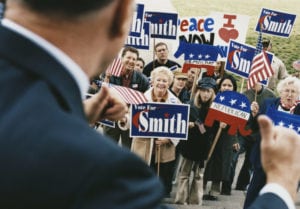 October 2015 CEO Column: Local Elections & Newspapers
October 2015 CEO Column: Local Elections & Newspapers
To download a Word version of this column for publication, please click here.
November is election time in America. Voters in many local municipalities will go to the polls soon to choose local public officials. Four states have statewide legislative elections and three of those states will select a governor. For some, the presidential election next year is top of mind. But it is the breadth and depth of local elections in this country that truly astounds. Try and wrap your mind around the idea that there are more than 87,000 elective bodies filled with over half a million elected officeholders.
So the notion that “all politics is local” rings true. Popularly attributed to former House Speaker Tip O’Neill, the phrase actually originated with a newsman. In a syndicated column penned in 1932, Associated Press Washington Bureau Chief Bryon Price wrote, “all politics is local in the last analysis, and local considerations come first.”
Local news media are the link between prospective voters and candidates vying for office. Newspaper media — in print and in digital form — are especially well-positioned to make this connection. New research data from Nielsen Scarborough show that among adults who always vote in local elections, seven in 10 read newspaper media in print, online or on mobile devices in an average week. The data also show that among persistent voters in local elections there is little difference between self-identified Democrats, Republicans and Independents: seven in 10 of each group are engaged with newspaper content in print or online in a typical week.
In addition providing news coverage of candidate speeches, debates and events, newspaper voter guides are a crucial resource to help voters make informed decisions. The voter guide in print form, sometimes appearing as a special pull-out section, has been a staple of newspapers for years. These pages alert voters to polling locations and absentee ballot procedures, as well as candidates and their stances on issues.
Digital newspaper platforms now make local voter guides even more useful, with interactivity that drills down through the maze of local legislative districts using the voter’s location. For example, the Dayton (OH) Daily News online voter guide, Your Vote 2015, allows voters to browse 293 races and 447 candidates, or enter their location or address to find specific individual races. In Texas, the Dallas Morning News election guide has interactive features to help voters navigate through the seven proposals to amend the Texas constitution. The guide also provides instructive context for voters: While the U.S. Constitution has been amended 27 times, their state constitution has been amended 484 times.
Online voter guides are not just the purview of newspapers in large markets. The York (PA) Daily Record has extensive detail on races for offices in townships and boroughs, for school boards, judges and commissioners. The Wilmington (NC) Star News voter guide covers three counties with information on 22 races and 87 candidates, along with interactivity by the voters’ address or location.
The all-embracing coverage of local elections by local newspapers in all forms is not something that is duplicated by television or radio stations, or other media outlets; they simply do not have the capability of local newspapers to cover the myriad candidates and issues in all localities.
Elections are a local business. Newspapers are a local business. The connection between the two is essential for democracy to function.

About The CEO
David Chavern serves as President & CEO of the News Media Alliance. Chavern has built a career spanning 30 years in executive strategic and operational roles, and most recently completed a decade-long tenure at the United States Chamber of Commerce.
